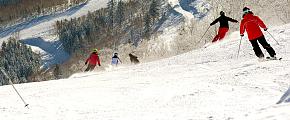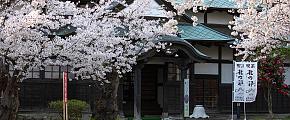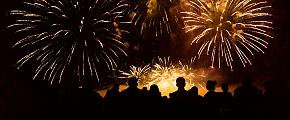Snow Monkey in Hot Springs: Facts & Where to See
From capybaras with yuzu on their heads to adorable penguins marching across snow-covered Hokkaido, many animals embody the charm of Japanese winter. Yet, if there is one that stands out, it's the snow monkey soaking in hot springs. Despite its name, you can encounter these delightful furry friends throughout your year-round Japan tour. Read on and you will find your answer.
What Is Snow Monkey (Japanese Macaque)
Native to Japan, the snow monkey, or Japanese macaque, is the only species of monkey found in the country. They are highly social animals that live in large groups, with thick brownish-grey fur to keep warm, short tails, and iconic pinkish faces that turn reddish during their winter hot spring baths. This interesting behavior attracts many visitors to the mountain onsen park to witness this serene moment.
Facts About Japanese Snow Monkey | |
| Name | Japanese Macaque, Nihonzaru |
| Height | 55cm |
| Weigh | 11kg for Male, 8kg for Female |
| Tail | 9cm for Male, 8cm for Female |
| Diet | Omnivore (Plant, Fruit, Seed, Insect, Root) |
| Habits | Active in the Day, Semi-Terrestrial, Matrilineal Society |
| Habitats | Honshu, Shikoku, and Kyushu |
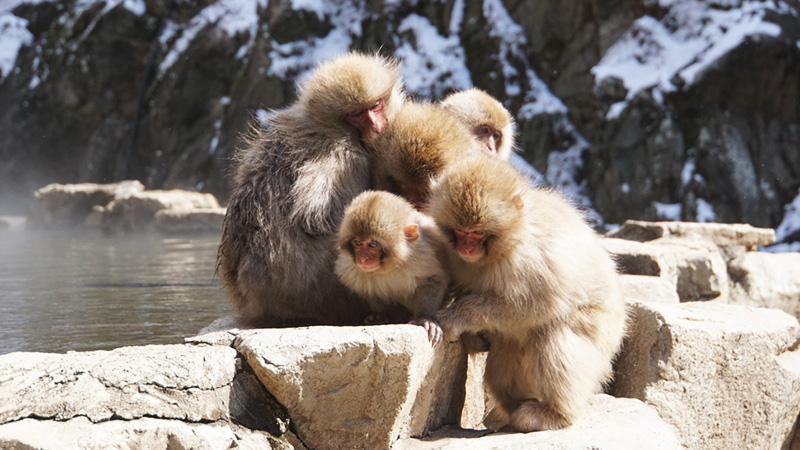 Snow Monkeys
Snow Monkeys
Why Is It Called Snow Monkey
The name of Snow Monkey may be relative to their behavior. One of the reasons is their well-adapted nature to the chilly winter.
Japanese monkeys live in mountain forest areas which usually with months of snowdrops, and are still active during the winter season instead of hibernating - they are very good at taking advantage of the natural hot springs. Just packing together and soaking in the steaming water, with fallen snow flowers dotting their furry coats. After their pleasurable ways of spending winter became known to humans, Japanese macaques were given their new name, Snow Monkey.
Where Do Snow Monkeys Live
As the only monkey species native to Japan, it is quite common to see snow monkeys in Japan's forest mountains, no matter the subalpine or evergreen ones.
Their large family groups can be found throughout most of the country, from Kyushu and Shikoku in the south to various parts of Honshu Island. However, their coats may not be thick enough to keep them warm on the northern island of Hokkaido, making Japanese monkeys only found south of the Blakiston Line.
Where to See Snow Monkeys in Japan
To capture the adorable snow monkey during your Japan journey, consider adding Nagano or Kyoto to your itinerary, where large groups of Japanese monkeys live.
Thanks to their friendly nature as well as social interactions, you can also find several parks dedicated to Japanese macaques instead of a deep wilderness expedition. From the notable Arashiyama Monkey Park Iwatayama to the Jigokudani Monkey Park features hot springs, there are plenty of opportunities to encounter their daily life.
Arashiyama Monkey Park Iwatayama, Kyoto
With around 120 wild, uncaged Japanese macaques living freely in the tranquil mountains, this easily accessible park is nestled beneath Arashiyama. It is only a 30-minute drive from the center of Kyoto. After meeting your furry friends, you can also visit the nearby Arashiyama Bamboo Forest and Kinkaku-ji, especially during the fall foliage season from October to November.
Walking up the winding mountain path to the top, it is easy to come across these red-faced macaques, swinging from the branches, resting in dramatic poses, or wrestling with each other. You can walk with them around the mountains as they are quite accustomed to human visitors.
What makes this park special is that feeding is allowed, making it an ideal destination for families and kids. This means that after admiring the Kyoto skyline, you can also buy some food from the park to feed them at the special area - a hut with netting instead of a window, where the humans become the ones inside the cage.
Arashiyama Monkey Park Iwatayama | |
| Opening Hours | 9 AM to 4 PM |
| Opening Times | Daily, Closed on January 1 |
| Admission Fees | 600 JPY for Visitors Over 16, 50% for Visitors Under 15, and Free for Children Under 3 |
| Notes | No Smoking & Cash Only |
Snow Monkey Park (Jigokudani Yaen Koen), Nagano
The Snow Monkey Park in Nagano is a year-round park that always welcomes your visit. Situated in a steaming valley with natural onsen, it is one of the best places to capture snow monkeys bathing in the soothing hot springs.
After a 50-minute drive from Nagano to the Jigokudani Valley, there is still a 30-minute walk along the forest trail to the gate of Snow Monkey Park, making the boots and snow equipment quite necessary during your winter visit.
The special troop (of about a hundred wild macaques) lives in the cliff forest and descends to the valley's hot springs during the chilly winter. However, you can still observe the Japanese monkeys around the hot spring area year-round, as they are also fed by park staff, often washing their food or playing in the water.
However, the hot springs in the park are for monkeys only. The good news is that there are also onsen hotels at the foot of the mountain, where you can enjoy your own hot spring experience. These range from steaming indoor baths to refreshing open-air ones for enjoying both hot water and falling snow. Luckily, you may even have an occasional furry friend join you in the bath.
Snow Monkey Park (Jigokudani Yaen Koen) | |
| Opening Hours | November to March: 9 AM to 4 PM April to October: 8:30 AM to 5 PM |
| Opening Times | Daily, Including Public Holidays |
| Admission Fees | 800 JPY for Adults, 50% for Teenagers Under 18, and Free for Children Under 5 |
| Notes | No Flashing Photos & Feeding |
 Snow Monkeys in Hot Spring
Snow Monkeys in Hot Spring
Minoh Park, Osaka
Minoh Park, or Minoo Park, is a remote forest valley about half an hour's drive from Osaka, home to sacred temples, a magnificent waterfall, and wild Japanese monkeys in their most natural habitat, offering a leisurely and surprising hiking experience.
Though this park is famous for its splendid fall colors from late November to early December, it is also a good place to start your summer getaway. Deep in the lush forest, with gentle breezes and splashes of water echoing throughout the valley, and mischievous macaques roaming the forest trails and hanging out at waterfall areas for their food and rest.
Minoh Park | |
| Opening Hours | 24 Hours |
| Opening Times | Daily, Including Public Holidays |
| Admission Fees | Free |
| Notes | No Feeding, Not as Usual as in Dedicated Monkey Parks |
Awaji Monkey Center, Sumoto
About a 2-hour drive from Osaka, the historic Awaji Monkey Center is another place to see Japanese snow monkeys, with a huge number of around 350. Macaques here are also known as Awaji Monkeys for their friendlier, closer, and more tolerant nature, ideal for animal lovers to get close contact with them.
Although feeding is still staff-led here, their mild nature means that family members, regardless of rank, will eat together, showing the unique monkey letters of the Japanese character "saru" during their meal.
They are also still wild and return to the forest in the evening, so don't forget to come earlier if you want to spend more time with these gentle friends.
Awaji Monkey Center | |
| Opening Hours | 9:30 AM to 5 PM |
| Opening Times | Daily, Closed on Thursday |
| Admission Fees | 700 JPY for Visitors Over 11, 50% for Visitors Under 10, and Free for Children Under 7 |
| Notes | From September to November, Monkeys Will Return to the Mountains |
Takasakiyama Monkey Park, Oita
It is a mountain reserve home to over 1000 wild Japanese macaques, with two troops where you can observe one of the largest groups of monkeys living without nets or fences.
It has a much quieter and more peaceful atmosphere due to its remote location and is a more off-the-beaten-track attraction, offering an immersive experience with the furry monkeys.
After a 2.5-hour drive from Fukuoka, a 20-minute walk uphill or a 5-minute monorail ride brings you to where the monkeys gather, playing for fun and grooming each other. During feeding time, you'll witness swarms of macaques descending the mountain, which is quite an exciting scene to see.
Takasakiyama Monkey Park | |
| Opening Hours | 9 AM to 5 PM |
| Opening Times | Daily, Including Public Holidays |
| Admission Fees | 520 JPY for Visitors Over 16, 50% for Visitors Under 15, and Free for Children Under 7 |
| Notes | Feeding Every 30 Minutes |
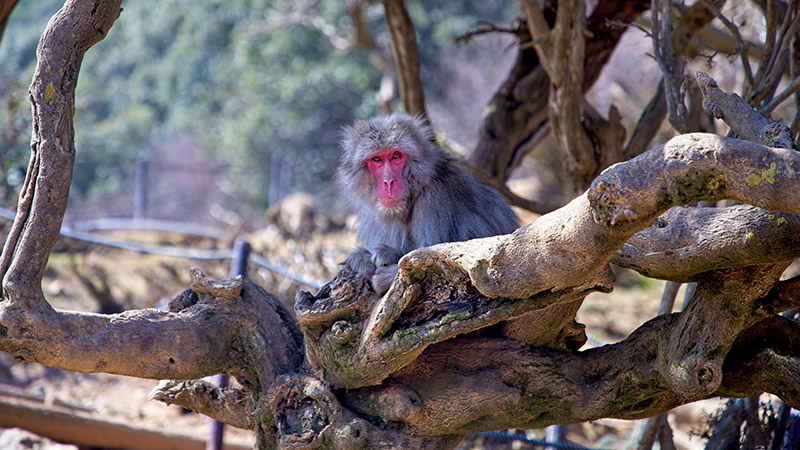 Snow Monkey
Snow Monkey
The Best Time to See Japanese Snow Monkey
The best time to see snow monkeys in Japan is quite a long period. You can see the Japanese monkey all year round, so no matter when you start your Japan holiday, the visit can be added to your itinerary.
A spring break from March to May can combine your pinkish-red face friends' visit with the pink cherry blossoms, which is also a great time to catch baby monkeys just learning to walk.
In autumn, also the mating season, there may be only a small group of monkeys in parks as the fruits and nuts harvested in the forests attract their attention.
An early summer trip in June is recommended to catch their active behavior, and for their dramatic faces and postures soaking in hot springs, the winter season from November to February is always the best time.
Tips for Visiting Japanese Monkey
Be Aware of the Weather & Snow
Although most Japanese snow monkey parks are open every day, they may close in extreme weather conditions such as storms and heavy snow, especially the Snow Monkey Park in Nagano, which requires half an hour's walk to reach. Check the schedule and always be prepared for the snow trail during your winter holiday.
Show Your Friendly
Even though most Japanese monkeys are familiar with interacting with visitors, usually non-aggressive or even pay no attention to visitors. However, always remember that they are still with their wild nature when visiting snow monkeys. No feeding, do not touch or stare at their eyes, and always keep your distance.
No Food Outside Your Bag
As an intelligent animal that knows how to take advantage of the hot springs, they have also learned which type of visitor will bring them food, so they become aggressive in foraging when their target - those with plastic bags in their hands - appear, making the special feeding area quite necessary.
Capture Snow Monkeys With Odynovo
It is always a pleasure to see those pictures of snow monkeys, soaking in hot springs with their dramatic pinkish-red faces with relaxing and enjoyable postures. Travel to Japan with Odynovo at [email protected] to make an appointment for you and your animal friends.
Quick Question
Related Posts You May Like
What Our Clients Say
Explore the latest verified reviews of Odynovo's travel services on Tripadvisor, Google, Trustpilot, Product Review and more trusted platforms.
SUBSCRIBE TO WIN A FREE TOUR
Subscribe to our newsletter for a chance to win a free 7-day tour to India! And more insider travel news, exclusive offers, and inspiration will be sent straight to your inbox. Check our previous newsletters and get some sparks.


